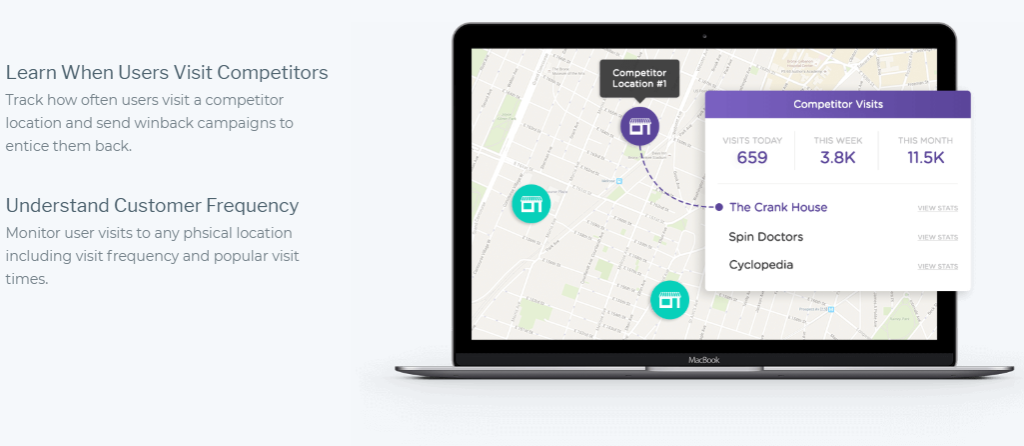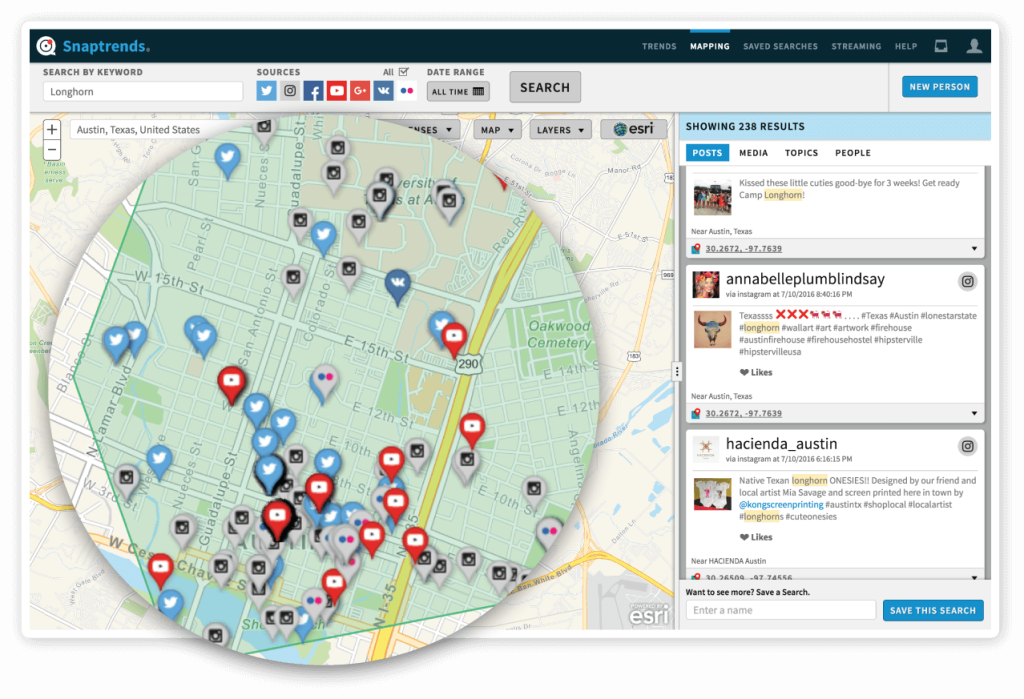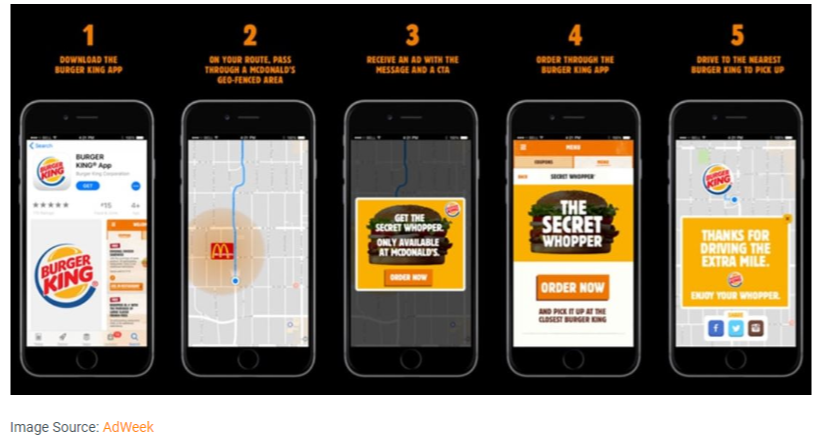SEO Guides, Tips & More!
Learn from Our Experience
Geofencing – Professional Service Firms
Professional services marketers should always be looking for new, innovative, and cost-effective ways to advertise their firms and differentiate their services. As more firms shift their marketing budgets to digital advertising, mobile marketing, and local SEO need to be part of this mix. In fact, when searching for ways to maximize tight budgets, location-based marketing should be a no-brainer: it gets a higher response rate and more customer and client engagement than traditional forms of marketing.
Recall from a previous Flashpoint blog post how much local SEO is growing (and ways to improve it). Local SEO is only the beginning. Geofencing is one form of hyper-targeted location-based marketing that accounting and law firms should be learning about and adding into their marketing plans for 2020.
What is Geofencing?
Imagine drawing a circle around the firm’s location on Google maps, then targeting clients and prospects with an online marketing campaign when they’re nearby. That’s geofencing. Geofencing in its simplest terms is drawing a perimeter around a point on a map, setting up client actions based on when a mobile device enters or leaves the digital perimeter, which then triggers a mobile marketing campaign. For geofencing to work, people need to turn on their smart phone’s location sensor.

From a technical standpoint, this is how geofencing works. The marketing team:
- Establishes an online campaign with location-based calls-to-action.
- The campaign can include a mix of mobile push notifications, online display ads, email marketing, website remarketing, and/or social media marketing.
- Installs an app or downloads geofencing software.
- Sets a digital perimeter around GPS or radio frequency identification (RFID) coordinates, like around the firm’s office or its competitors.
- When a person enters or exits the digital perimeter, the marketing campaign kicks in.
- Ads are shown on that person’s mobile device for up to 30-60 days.
Geofencing is expected to grow another 27 percent over the next few years due to technological advancements and demand across at least six to eight major industry verticals. It’s growing for good reason: it yields double the click-through-rate and is up to 20 times more effective than traditional digital banner ads, according to Social Media Examiner.
In other industries, geofencing coordinates are also used to automate timecards for punch-in/punch-out and monitor company property. in the transportation industry, geofencing tracks shipments and in government and defense, it tracks drones and prevents them from entering restricted airspace. Retail businesses use geofencing to draw digital perimeters around their brick-and-mortar stores, then send push notifications through their stores’ apps to deliver customers special coupons or offers. Concert venues use geofencing to deliver real-time information about the musical artist and let promoters see and join in on live social chatter. Imagine being able to reach prospects as they’re talking about the event the firm is participating in (or hosting).

Benefits of Geofencing
Even though it seems like geofencing takes the concept of “big brother is watching” to a whole new level, there are a lot of benefits. Keep in mind that people are reporting they want more personalized experiences with advertisers. If it’s not immediately relevant and beneficial, the offer loses its value. Also, remember that we can’t ask people to do too much on their own for a marketing campaign to work. The fewer steps to reach the desired call-to-action, the better. Geofencing, unlike other forms of online marketing, takes a proactive approach to reach targeted audience segments exactly where they are with valuable content and offers. No extra steps to take.
Geofencing also helps to improve local SEO and in turn, increase local sales opportunities. Imagine all the people walking outside the firm’s office; most of them aren’t current clients, but many of them might fit the firm’s client profile. With geofencing, they can receive targeted ads and incentives to learn more about the firm as they’re walking past. Maybe it’s a new client offer of a complimentary review of past tax returns – but only if they schedule an appointment soon.
It’s also easy to measure and track. Marketing teams won’t have to wonder what brought prospects in the door – was it the ad in the local business journal, the Google Ads campaign, or maybe the ad in the regional industry magazine? It’s hard to tell unless the person says so-and-so referred them. With geofencing, not only can click-through-rates and on-page metrics be measured, but previously unknown data like how long they’re in the office, how often they visit, their name, and more. This level of knowledge helps marketing teams improve their client profiles and prospect demographics.

Geofencing for Accounting and Law Firms
Wondering how to put this tech to work for accounting and law firms? To begin with, firms that already have an app should be tying it to any geofencing campaign.
Trade Shows
When the firm is exhibiting at a trade show or conference, geofencing can drive foot traffic to the booth and deliver targeted ads during and after the event. If physically being at the trade show or conference isn’t possible, geofencing still allows the firm to “participate” by setting a digital perimeter around the event site and delivering a contextual offer to attendees (think: “Sorry we missed you! Click here for [insert offer].”)
This case study described a national accounting firm that used geofencing to drive visitors to its booth at a trade show. At the event, the firm used a geofencing campaign to drive foot traffic to their booth. During and after the event, the firm used IP address targeting and site retargeting to achieve a click-through-rate of 0.15 percent compared to the industry average of 0.1 percent.
Tax Season
During tax season, accounting firms can use geofencing to target people who are physically within a mile or two of their office with a time-sensitive offer or downloadable content.
Hosted Events
Many firms regularly host a networking or other continuing education events. While the event is happening, set up a geofence to send attendees to push notifications about a related piece of downloadable content.
Audit Fieldwork
Geofencing can also be used to track employees’ locations, like when audit staff report to a client to do fieldwork or is otherwise off-site.
Social Media
Especially if the firm has a Snapchat account, geofencing can be used with location-based filters, stickers, and other shareable content. Location-based filters and profile badges can also be used with Facebook. Pair this with a trade show or hosted event, and it’s the makings of a highly personalized, interactive campaign.
Competitors
Easily track the firm’s competitors using geofencing. When someone is near a competitor’s office, set up a campaign that sends targeted ads or offers from your firm. Think this is crossing the boundaries of professional propriety? Ask Burger King. Their Whopper Detour campaign was a thing of evil genius that resulted in millions of downloads and over 500,000 redeemed coupons – all through targeting McDonald’s customers. All’s fair in love and war … and accounting.

Besides competitors, geofencing can also be set up around the digital perimeter of complementary businesses. Accounting firms could consider wealth management or law firms whereas law firms could use courthouses or banks, for example.
Geofencing Best Practices
Ready to try geofencing? Here are some industry best practices to help the campaign be successful.
- Keep the digital perimeter small. A general rule is a four- to five-minute travel radius.
- Set a clear and immediate call-to-action so people will respond quickly.
- Let people know that a limited amount of their digital information is shared with the firm, but also give them the confidence that their information is protected.
- Integrate other digital marketing tactics, like retargeting, AdWords, and social media advertising to reach people at various points in the digital marketing funnel.
- Optimize the geofencing campaign with SEO.
- Utilize A/B testing for digital ads to see which one performs the best.
Security and Privacy
Geofencing naturally gives way to concerns about security and privacy, and for good reason. Although it can feel invasive, it can also be used to unlock car doors or turn on house lights when the owner’s mobile device is five minutes away. Still, transparency is key. Clearly communicate what data the firm can see and how it will be used. Accounting firms must use caution not to use any data from clients’ tax returns – or data that could be perceived to be from tax returns – in any marketing campaign. And law firms equally need to keep sensitive client data protected, such as legal notices that aren’t public or medical information, in the case of personal injury lawyers.
Parting Thoughts
Geofencing can work without SEO optimization, but why anyone would want to try doesn’t make sense to us. Make sure to involve an SEO expert to take any geofencing campaign to the next level.
Geofencing has the potential to take digital marketing efforts to a whole new level. Even if the gut reaction to this technology is negative or overly intrusive, keep in mind many companies are already using it to help connect you to more targeted offers. Why shouldn’t accounting and legal marketing be able to do the same?
Have you used this tactic? Tell us in the comment section below about the results!

